In most world history survey courses, Arabia is introduced for the first time only as backstory to the rise of Islam. We’re told that there was a tradition of oral poetry in Arabic, a language native to central Arabia, and that the Qur’an was the zenith of this oral tradition. New evidence, however, suggests that Arabia was linguistically diverse, that the language we’ve come to know as Arabic originated in modern day Jordan, and that the looping cursive writing system that’s become the language’s hallmark wasn’t the original system used to write it. What to make of all this?
Guest Ahmad al-Jallad has spent the past several summers digging in Jordan and Saudi Arabia, uncovering new inscriptions thousands of years old, and shares his research that’s shedding new light on the writings of a complex civilization that lived in the Arabian peninsula for centuries before Islam arose.
Guests
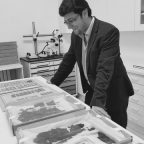 Ahmad al-JalladM.S Sofia Chair in Arabic Studies at the Ohio State University
Ahmad al-JalladM.S Sofia Chair in Arabic Studies at the Ohio State University
Hosts
 Christopher RosePostdoctoral Fellow, Institute for Historical Studies, The University of Texas at Austin
Christopher RosePostdoctoral Fellow, Institute for Historical Studies, The University of Texas at Austin
Today we’re going to be talking about writing in ancient Arabia, and the alphabet. As were discussing earlier, Arabia pops up [in world history texts] about 50 years before Islam only in the context of the background. For people who are familiar with Qur’anic studies, the Quran is traditionally considered to be the high point of this tradition of ancient Arabian writing and poetry. Obviously it didn’t come out of a vacuum, so what do we know about ancient Arabia and its written tradition of writing and literature? And who was writing? And what were they writing?
So writing in Arabia begins about 1500 years before the Quran. The earliest datable documents come from ancient Yemen, they’re wooden sticks that were used for writing contracts, personal letters, and these can be carbon dated, and the earliest one is about the 10th or 11th century BC. The language of these documents is not Arabic, its an ancient south Arabian language called Sabaic. The script used on these documents is not directly related to the Arabic script either. It’s what scholars call the south Semitic script. It’s an alphabet of about 28-29 letters depending on the variety. Ancient Yemen has a continuous writing tradition in this alphabet, using basically indigenous languages like Sabaic, and there are three others: Qatabonic, Minnaic, Hadramitic for about 1,500 years.
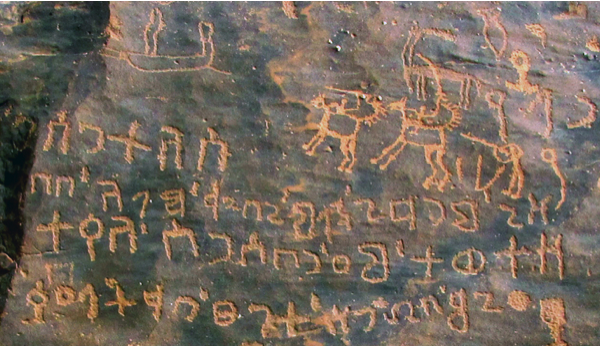
Now the rest of the Arabian peninsula also had writing traditions, so the oasis of northern Arabia, for example, Dadan, which is an oasis about 180 miles north of medina had its own local script. Taymah, a great oasis of northern Arabia as well, had its own writing tradition, its own script. and also there are languages distinct from arabic. those ones are a little bit harder to date because no perishable materials survived bearing writing from those oasis, so we have to infer from other contexts, so in Taymah for example, you have some inscriptions referring to Neponitus, king of Babylon, who occupied the oasis from 553 BC to 543 BC, so we’re talking middle of the first millennium BC. So, Arabia is unique in that it wasn’t only settled people who would have uses for writing, but the nomads of Arabia were also literate, from the deserts of southern Syria all the way to Yemen. There are tens of thousands of inscriptions in varieties of the south Semitic script produced by nomads in a variety of languages, some very close to arabic, and some rather exotic and ultimately undeciphered.
Do we have any idea what the spoken languages were like or is it hard to infer from the written evidence?
The epigraphic record of Arabia reveals considerable linguistic diversity. In ancient Yemen you have a group of languages that scholars call Ancient South Arabian, Sabaic is a language associated with the kingdom of Saba—Biblical Sheba—and you have Qatabonic,Minnaic,Hadramitic, 4 neighboring kingdoms, each of these languages or sometimes they’re called dialects, they’re rather distinct from each other, but whats really interesting is that they are very different from arabic and were definitely not mutually intelligible with arabic. When we go north into the Nejd, into the Hijaz, the areas north of, for example, Medina, the areas north of riyadh around Ha’il in saudi Arabia, the inscriptions are much shorter, most of them are just personal names, and so its difficult to determine what the language of the writer was. But when you do occasionally get a longer inscription, these have till today, mostly defied interpretation. So that means that in the Middle of Saudi Arabia, you had indigenous languages that were very different form Arabic, that don’t have any modern descendants today.
The oasis towns of northern Arabia are also interesting. Dadan, which i mentioned earlier has a language that is similar to Arabic, but not quite Arabic. there are big differences between the two. The language of the oasis town of Taymah, has striking similarities with Aramaic and Hebrew against Arabic, so we’re looking at a quite a bit of linguistic diversity. Where you do encounter languages that look like the Arabic we’re familiar with, and that can be interpreted in a more consistent way, we find those inscriptions in Jordan, northern Hijaz, modern day Jordan, northern saudi Arabia around Tabuk, southern Syria, and these texts, they’re not classical Arabic. They are probably as different from classical Arabic was Beowulf is from Chaucer, but they are still recognizably Arabic and they are interpretable. So the epigraphic picture of Arabic, or, lets say, the epigraphic map of ancient Arabia is upside down from the traditional sources, which place Arabic in Yemen, and foreign elements being in the north, the epigraphic map actually looks the opposite.

You’ve mentioned that the writing systems are rather diverse, the languages are rather diverse, and that Arabic comes from what ironically later on be the Umayyad homeland, the sort of desert region of Syria, or what is now Syria and Jordan. So when does some of this evidence suggest a shift in a direction that those of us who have studied Arabic might consider more recognizable in terms of the writing? Ancient South Arabian is very distinct, but it is very different than modern arabic script. Where does that come from?
We have to make a distinction between language and script. Any language can be written in any script for example, so for most of Arabic’s attested history, so lets say stretching back 100 years before Islam, Arabic was most often written in a variety of the south Semetic script, very much like the ancient South Arabian alphabet that you have on the website. Its hard to say what our oldest attestations of arabic are, there were inscriptions recently published from the area of the Wadi Sirhan in Jordan, its a short Arabic inscription in a variety of the south Semitic script thats used in the north, not really like any of the known ones exactly, and it contains a prayer to Milcom, Chemosh, and Qaus. These are the three gods of the iron age Transjordanian kingdoms, Ammon, Moab, and Edom. The texts seem reasonably placed in middle or early first millennium.
Then you have a lot of inscriptions that are undated. We just have no idea when they were written. They were produced on rock, sometimes they’re just short prayers, personal names with prayers. We have no way to determine whether those were produced in the 4th century CE or the 4th century BC. But for most of Arabic’s history it was written in this way. Now the transition towards what is lets say familiar Arabic, the Arabic script that we learn in our first year classes seems to come with the establishment of the Nabataean kingdom. So the Nabataeans were an Arabic speaking group in what is today Jordan and northern Saudi Arabia, and to greater extent in southern Syria, even. They spoke Arabic but they administered their kingdom in a variety of Achaemenid Aramaic, official Aramaic, but you can see the influence of their spoken language, Arabic, on their written language, for example, the way that they phrase things, some of the words they use are coming from Arabic. and theres a nice collection of legal papyri from the Dead Sea where you have Arabic glasses to explain Aramaic terms, which is quite nice.
So the Nabataeans are conquered by the Romans in 106 CE. Throughout this period they are writing primarily in Aramaic, even though they are speaking Arabic. After the fall of their kingdom, the Nabataean script and writing tradition, the use of Nabataean Aramaic, the particular kind of Aramaric survives in northern Arabia, and you start to see the intrusion of more and more Arabic. In 328 CE, an epitaph was produced for a king named Mal Qays or Imrou Qays, we can’t exactly determine the pronunciation, son of ‘Amrou who calls himself “Malek al arab kulla“—King of all the Arabs, and this is in the Nabataean script, but the language, which, except for the word for son—they use the aramaic bar—is Arabic, completely Arabic. So we see, at least at this point, the use of the Nabataean script to write Arabic language, and in a context of prestige. And, basically between the 3rd century CE and the 5th century CE, a great scholar of Nabataean epigraphy, Layla Nehmé identified this as a transitional period between the Nabataean Aramaic script and what is recognizably the Arabic script. And the language of this period is mostly Aramaic, although there are more and more Arabic intrusions. So this would be the beginning of the Arabic script as we know it. Now, why this script then spread and replaced the indigenous alphabet of Arabia that was used for over 1000 years is unclear.
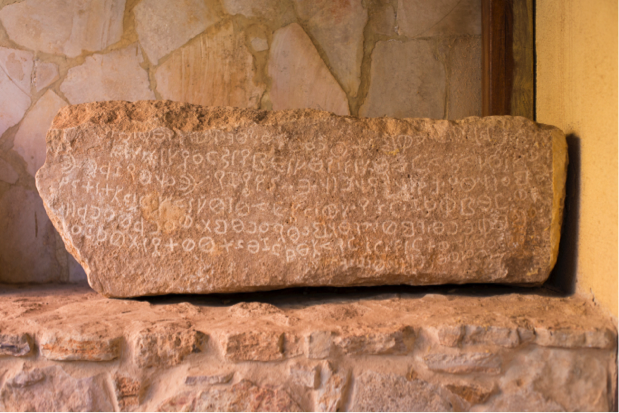
This is fascinating because as I discussed in the episode on the Burmingham Quran, that early cursive arabic script is inadequate, it had to be modified with dots, the dots that people are familiar with in order to make it fully representational of the sounds that arabic has, but that process took a couple of centuries after the Quran. So any idea why one script that was imported, that didn’t fully represent how arabic sounded replaced the other? Or is that lost in the historical record?
So the transition from Nabatean Aramaic to what is recognizably the Arabic script is in many ways a transition to a more cursive script, and the only time cursive writing has any use is when you’re writing with ink on perishable materials. This indicates that Arabic developed in the context of writing with ink rather than on rock, and was probably sued for administration, was probably used for day to day documents. Now anyone looking at receipts and contracts will notice that these documents are incredibly formulaic. You already know what to expect when you’re looking at the documents so that you don’t need to full phonetic representation of your language to be able to successfully decipher a text. If the Arabic script developed out of an administrative tradition, then full phonetic representation was never a limitation to being able to read a document.
The South Semetic script, scripts like Safaitic and Hismaic, these were scripts that the Arabic language was written in before the spread of the traditional Nabataean script and ultimately the Arabic script as we know it today, this scripts represented each one of the Arabic consonants with a distinct glyph. There was no redundancy. You didn’t need to use dots, you didn’t need to guess. There were still no vowels, because it was a Semitic script, but all the consonants were there, but we have no evidence that the people who employed those scripts, who seem to have been primarily nomads, we have no evidence that they used those scripts for practical purposes. Most of the inscriptions that we see written in these scripts were memorial, votive, or just simply graffiti, so we don’t have any evidence that these scripts were used for practical purposes. The Arabic script that we know developed, probably in the chancellories of tribal kings and had a completely different function to begin with.
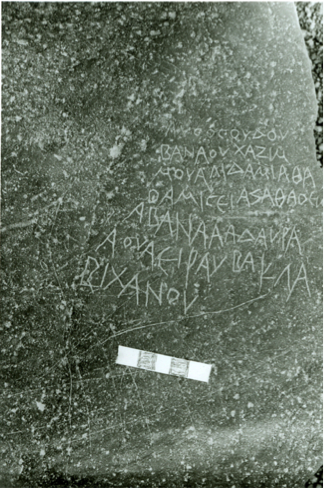
Its interesting to think about it in that context. You mentioned the issue of Arabic with contact from Aramaic. One of the other things that came up—I confess that I wasn’t terribly nice to him—in the Birmingham Quran episode was Kristof Luxemburg’s theory that the Quran is better understood if you read portions of in Syriac, which is an Aramaic dialect or register. Based on that history of language contact, and the fact that the script actually came from Aramaic, is there any weight to that theory?
One of the very influential myths that have shaped the understanding of the history of Arabic has been that Arabic before Islam—especially Arabic spoken by nomads—was isolated from outside influences. Now, you don’t need archeology to know that isolation and nomads do not go together, but nevertheless, when we go out into the desert and look at the inscriptions produced by the nomads in, for example, the Syria-Jordanian desert in northern Arabia, and the Jordanian harra—this is the basalt desert in northern Jordan and southern Syria—will we get inscriptions in the south Semetic script, local Safaitic—but we also get bilingual texts. So some speakers of Arabic will write their names in the indigenous script, in Safaitic but then again in Greek. And the Greek is …they inflect their names correctly in the right cases and sometimes they’ll give tribal affiliations, but its ok Greek, i mean for what it is, personal names, but it shows that they have knowledge of both scripts.
Theres one interesting example where a nomad from north eastern Jordan who clearly knew the Greek script, but didn’t seem to know the Greek language, wrote an inscription in old Arabic language, but using Greek letters. So he gives his name, he starts out with his name in Greek, putting the correct case endings on it, and then he runs out of Greek and starts writing his little graffito, which basically says “I came from the town here in the winter and I’m pasturing on fresh herbage.” And he gives his nisba—his tribal affiliation—al-idami. So, in the deserts we have a lot of evidence for Arabic-Greek contact, and that was something that was unexpected. Not so much Aramaic, in fact there were more bilingual Old Arabic/Greek texts in the desert than there are Aramaic ones.
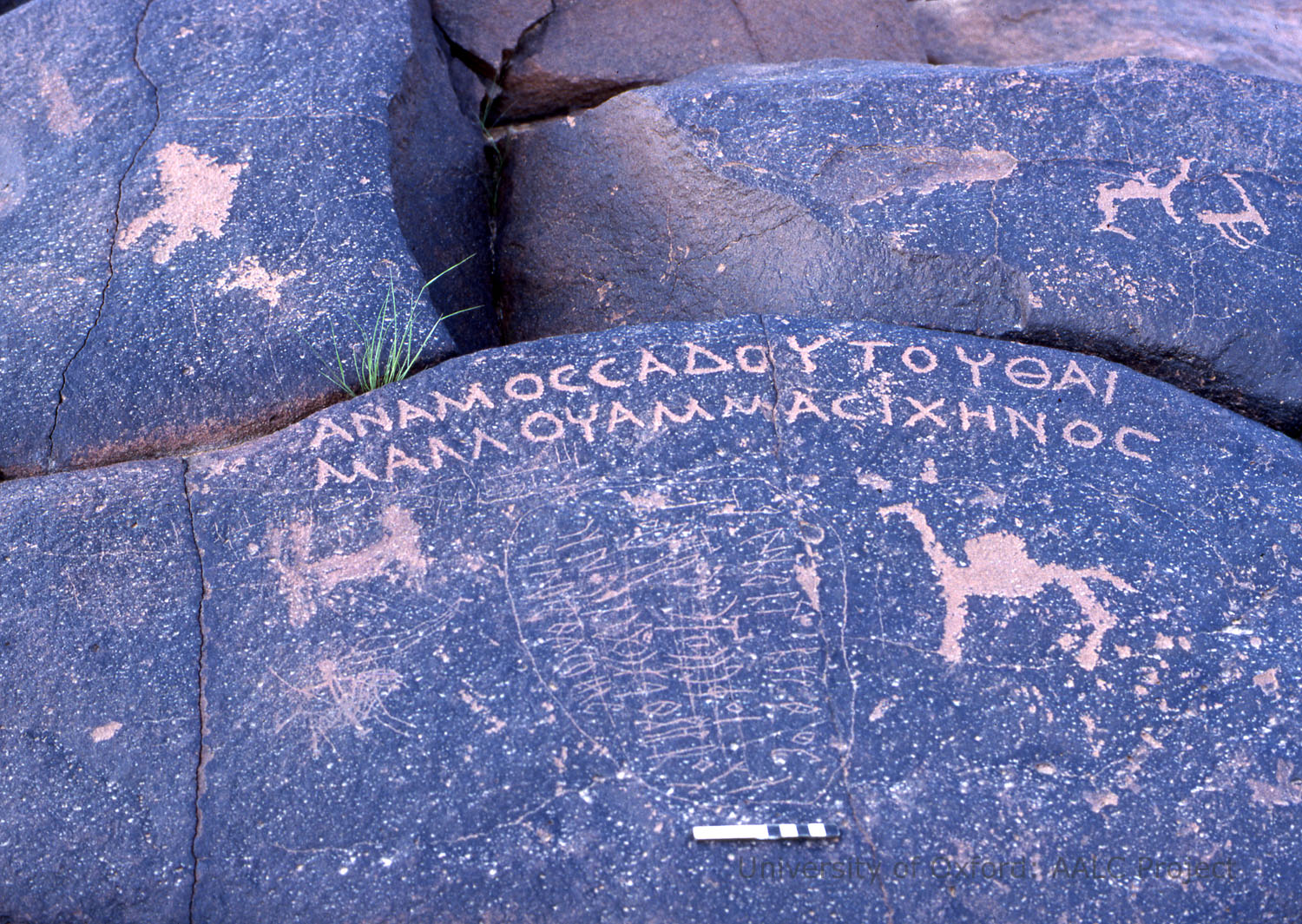
In northern Arabia, though in between the 3rd and 5th centuries CE, where you start to get this transition from Nabataean to the Arabic script, there you find a situation that looks like Luxemburg’s Qur’an. So you get inscriptions that are blended between Arabic and Aramaic. The introductory formula “may so and so be remembered well,” may be in Aramaic, but then parts of the prose will be in Arabic. The dating formula will be in Aramaic and then the prayer and the curse will be in Arabic. Interestingly, the word for son is always given in the Aramaic—”bar.” These texts show a high contact, almost code-switching between Arabic and Aramaic in writing at least. We don’t know if these people actually spoke Aramaic, but at least when writing they would use Aramaic formulae in certain parts of their inscriptions.
The Qur’an doesn’t look like those texts though. So, for example, the word for son in the Qur’an is never “bar.” We do have examples of Luxemburg’s hypothesis in these texts, and we can compare these texts to the Qur’an, and they do look rather different. One of the hallmark examples of Aramaisisms in the context of Arabic, the word for son, “bar,” is just not found in the Qur’an.
We know that they’re is all this linguistic diversity now, but of course according to the histories that were produced by, say, the late ‘Abbasid period around the term of the millennium in the Christian counting, Arabia was, and as you mention in particular the Bedu were speaking a pure arabic language. The Quran itself says repeatedly that it is in a pure Arabic language, but we know that that was not necessarily, at least prior to the advent of Islam, the case. So why was all of this forgotten?
Thats a very good question. So looking at the epigraphic map of Arabia the way that I present it, we need to explain the “Arabicization” of Arabia. Just like Egypt and North Africa were “Arabisized” after the Islamic conquests, at some point in the history of the Arabian peninsula, the languages, the more exotic languages that I talked about like those of the Thamudic inscriptions, the indigenous languages of the oasis of Tayma, of Dadan, and the ancient south Arabian languages, those eventually disappear and are replaced by Arabic. We just don’t know when. Thats more difficult to answer.
This transitional period, the 3rd to the 5th century, where we see the development of the arabic script, and the spread of the arabic script across North Arabia, thats writing, and it may be the spread of a writing tradition, but we can’t be sure that that represents any kind of linguistic change in the spoken language of these people. So we don’t know exactly when these languages disappear. If we go back to the harra, the basalt desert between Syria and Jordan, we simply don’t know when the inscriptions of that era end. None have been found in any kind of archeological context. A minority of them are actually dated, and they’re dated to 1st century BC to, lets say, the 2nd century CE, but those are the dated ones and they are a tiny minority. We just simply don’t know when these writing traditions end, and so its difficult to say really when these languages disappear, but i think what the epigraphic map forces us to think about, and it was probably a question that couldn’t have been asked 200 years ago or even 100 years ago, was when was Arabia Arabisized?
The Islamic conquest is an obvious turning point, and it could’ve been in that period, but it could’ve been much earlier. We must remember that the grammarians are describing the dialect geography over 100 years after the conquests, and theres a lot of controversy about the register, whether they’re after a spoken language or a performance register, its very unclear. The other question too is, when did these scripts disappear? We know by the Abbasid period there was no traditional knowledge regarding the scripts of North Arabia. So surely any visitor to the desert could see these inscriptions, but no one would know them.
In South Arabia, in Ancient Yemen, by the 9th century, the alphabet seems to have been retained. There’s at least one bilingual ancient South Arabian inscription from the Islamic period, but it’s just names. So its unclear whether it was just the alphabet that was retained, or if indeed there was a tradition that survived that wasn’t recognized, and nobody took any notice of to put in the mainstream histories. But we don’t when the alphabets completely disappear, but the great irony is, when it came time for the Qur’an to be written down, to be put into written form, it wasn’t one of Arabia’s indigenous scripts that was used to write the language. It was ultimately a foreign alphabet, a very developed form of a Nabatean Aramaic script.